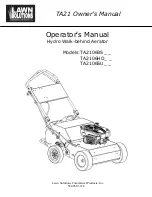
50
SPI Communications (Optional)
Several members of SPI: The Plastics Industry Trade
Association defined a communications standard to
various pieces of plastic processing equipment to
communicate. They chose to adopt the Serial
Peripheral Interface bus (SPI bus) which coincidently
has the same abbreviation as the trade association.
To allow our unit to operate as a slave unit in a
plastic processing system using this protocol, we
offer an option that includes an expansion module
for the control board and a RS-485 communication
port on the unit. The communication hardware
firmware is SPI 3.01 standard compliant.
Units ordered with this option will have this feature
activated at the factory. If for some reason this
feature is inactivate it may be active using the
program menu Communication Type function. See
Table 17 for details. In addition to activating the
communication type a baud rate and SPI address
must be set. These are set using the Communication
Baud Rate and SPI Address functions as shown in
Table 15.
If multiple pieces of equipment are going to be on
the same SPI communications network, the base
addresses of each machine has to be unique. The
communication baud rate may also need
adjustment.
Table 17 - SPI Parameters
Command
Poll
Select
Description
Echo
20 20
20 21
This is the controller integrity command used to accept and retain data
and provide it in response to a poll inquiry. This is an open 4 byte ASCII
format with ASCII units.
Version
20 22
This is the controller version command used to provide a version
number following format: AABB, where AA = SPI assigned version level,
BB = vendor assigned version level. This is in an open 4 byte ASCII
format with ASCII units.
Setpoint Process
Temperature
20 30
20 31
This is the temperature which the process supply is to be maintained.
This is a numeric format in °F.
Alarm, High
Temperature Deviation
20 32
20 33
This is the valve in conjunction with the process setpoint that determines
the high alarm temperature. This value must always be positive. This is a
numeric format in °F.
Alarm, Low Temperature
Deviation
20 34
20 35
This is the value in conjunction with the process setpoint that
determines the low alarm temperature. This value must always be
positive. This is a numeric format in °F.
Status, Process
20 40
This is the process status in a 16 bit format as follows:
0 = Controlling
1 = An alarm is present
2 = An alarm affecting the process has occurred
(high temperature deviation or low temperature deviation)
3 = An alarm affecting the machine has occurred
(probe fault or pump fault)
4 = The controller has exceeded its over setpoint deviation
5 = The controller has exceeded its below setpoint deviation
Содержание NQ Series
Страница 1: ...Installation Operation Manual NQ Series Portable and Remote Condenser Chillers...
Страница 2: ...Page Intentionally Blank...
Страница 75: ...Notes...
















































